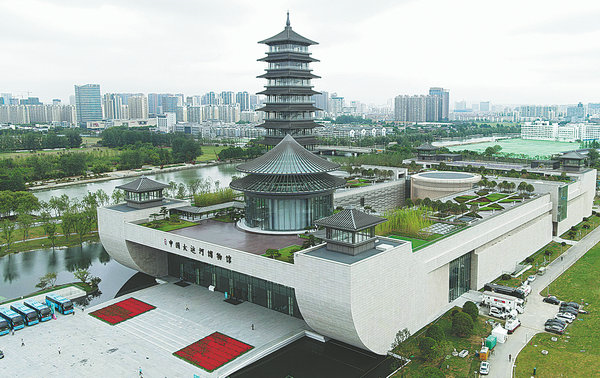

The China Grand Canal Museum in Yangzhou, Jiangsu province, which exhibits the history and culture of the Grand Canal has attracted a great number of visitors.
Yangzhou, standing alongside the Grand Canal-which stretches for more than 1,790 kilometers from Beijing in North China down to Hangzhou, Jiangsu province-was known for its prosperity in ancient times. The city's booming trade and commerce has close ties to the river.
From June 2021 to May 2022, the museum received 1.18 million visits. Each day, the museum provides 15,000 tickets for visitors to book in advance. They usually sell out on weekends, making the museum a sought-after landmark in East China.
It takes only 20 minutes to get to the museum by taxi from the Yangzhoudong Railway Station."Since the museum opened last year, nearly half the passengers I picked up at the Yangzhoudong Railway Station were headed there," said Cao Weihong, a local taxi driver.
"My passion was kindled by those passengers, so I took my children to the museum too. I never knew why it had such great charm until I got there. As a Yangzhou resident, I am very proud of such a museum," Cao said.
The museum, whose exterior resembles a giant ship, covers 80,000 square meters and houses 14 exhibition halls. Two long-term exhibitions are The Grand Canal of China-A World Cultural Heritage Site and Born of Transportation-Impression of Streets Along the Grand Canal.
"At the museum, visitors can also appreciate the history and culture of canals in other countries. A carnival mask from Venice, Amsterdam's canal houses and sculptures from Thailand are all displayed," said Zheng Jing, curator of the China Grand Canal Museum.
While telling the story of the canal, the museum puts an emphasis on improving visitors' experience. Young people can take part in a live-action role-play game designed by the museum, transporting them back to the Ming Dynasty (1368-1644), and immersing them in a world where they must unravel a storyline with their knowledge about the Grand Canal.
"During the process of solving the mystery, we learned about canal management institutions in the Ming Dynasty and products transported on the Grand Canal. It is definitely a very meaningful experience," said a visitor surnamed Chen.
According to the museum, the game has become one of the most popular events in the museum. Eight sessions will be held per day, each involving 30 participants. For those eager to play, they have to book one week in advance.
"At present, we are riding on the waves of world cultural heritage protection, integration of culture and tourism, and youth education in museums. The past has proved that game-based education is a good choice," Zheng said.
The museum has also teamed up with the Suzhou Museum. Together they encourage visitors to explore the exhibits related to the Grand Canal in both museums.
At the Shifang Restaurant on the ground floor of the Yangzhou museum, foodies can enjoy delicacies and intangible cultural heritage foodstuffs received by cities along the Grand Canal.
"Being engaged in the integration of culture and tourism, museums are now more than exhibition spaces," Zheng said.
"Therefore, our museum is committed to creating a comprehensive cultural and leisure space, and offers visitors from all over the world a string of services including exhibition, study, activity, show, cultural creative product and catering."